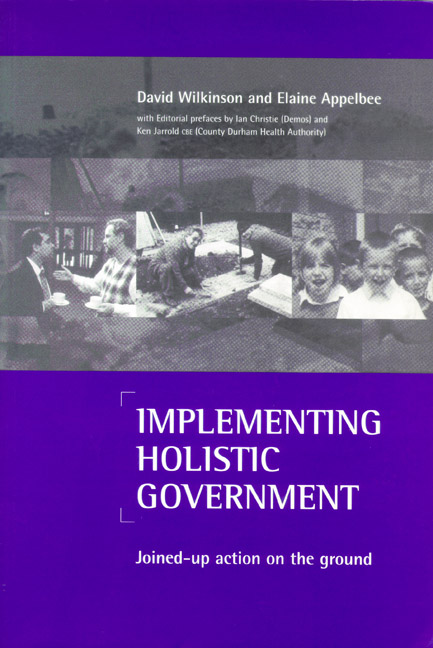Book contents
- Frontmatter
- Contents
- Editorial preface
- Editorial preface
- Acknowledgements
- Summary
- 1 Setting the context
- 2 The functional inheritance and its consequences
- 3 The public service, community interface
- 4 Change that works – sustaining community and quality of life improvement
- 5 Change that works – sustaining organisational and whole system change
- 6 Developing the middle ground: where bottom-up meets top-down (a third way for local governance?)
- 7 Improving sustainable quality of life: the benchmark for Best Value
- 8 Joined-up action on the ground: six key issues that have to be addressed
- 9 Working in the middle ground: recommendations to promote joined-up action on the ground
- References
1 - Setting the context
Published online by Cambridge University Press: 05 July 2022
- Frontmatter
- Contents
- Editorial preface
- Editorial preface
- Acknowledgements
- Summary
- 1 Setting the context
- 2 The functional inheritance and its consequences
- 3 The public service, community interface
- 4 Change that works – sustaining community and quality of life improvement
- 5 Change that works – sustaining organisational and whole system change
- 6 Developing the middle ground: where bottom-up meets top-down (a third way for local governance?)
- 7 Improving sustainable quality of life: the benchmark for Best Value
- 8 Joined-up action on the ground: six key issues that have to be addressed
- 9 Working in the middle ground: recommendations to promote joined-up action on the ground
- References
Summary
The new agenda for government in the twenty-first century is becoming clear. At its heart is the idea and the goal of ever more holistic government, built as much from the bottom up as from the top down. (6, 1997, p 70)
The shape of the new Labour government's public and social policy intentions is now emerging. There is recognition that a series of intractable issues cannot be resolved in isolation. The causes of social exclusion, criminality, unemployment, poor health, low educational attainment, poor housing and welfare dependency, are interlinked and multi-faceted. The Prime Minister has frequently talked of the need to keep the bigger picture in mind and called for “joined-up solutions for joined-up problems” (The Times, 9 December 1997: leader column referring to the Prime Minister's launch of the Social Exclusion Unit the day before). After a year in government he has reiterated the point yet again. Writing in The Observer he says,
Even the basic policies, targeted at unemployment, poor skills, low incomes, poor housing, high crime, bad health and family breakdown, will not deliver their full effect unless they are properly linked together. Joined-up problems need joinedup solutions. (The Observer, 31 May 1998)
The logic and need are compelling. However, the history of previous attempts to coordinate policy, together with both the growth of scale and the establishment of very different managerial and professional cultures across the agencies of delivery, do not suggest this will be easy. It will require a major shift towards lateral working across different agencies in partnership with local neighbourhoods. While the new rhetoric is being advanced in every quarter, it is likely that the reality of implementation will be strongly resisted. There are two central reasons for this. Firstly, a great many people have an enormous investment in the power bases, career structures and the management, political and professional cultures of the status quo. These are essentially hierarchical and asymmetrical in relation to the horizontal and self-generating linkages required for change. Secondly, this status quo is reinforced by the historical emphasis on cure of the presenting problems rather than prevention in the first place. It is a Fordist rather than a quality approach. Making the switch towards longer-term prevention is likely to prove very difficult in many areas of provision.
- Type
- Chapter
- Information
- Implementing Holistic GovernmentJoined-Up Action on the Ground, pp. 21 - 26Publisher: Bristol University PressPrint publication year: 1999



